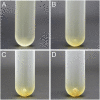Microbial growth at hyperaccelerations up to 403,627 x g
- PMID: 21518884
- PMCID: PMC3093466
- DOI: 10.1073/pnas.1018027108
Microbial growth at hyperaccelerations up to 403,627 x g
Abstract
It is well known that prokaryotic life can withstand extremes of temperature, pH, pressure, and radiation. Little is known about the proliferation of prokaryotic life under conditions of hyperacceleration attributable to extreme gravity, however. We found that living organisms can be surprisingly proliferative during hyperacceleration. In tests reported here, a variety of microorganisms, including Gram-negative Escherichia coli, Paracoccus denitrificans, and Shewanella amazonensis; Gram-positive Lactobacillus delbrueckii; and eukaryotic Saccharomyces cerevisiae, were cultured while being subjected to hyperaccelerative conditions. We observed and quantified robust cellular growth in these cultures across a wide range of hyperacceleration values. Most notably, the organisms P. denitrificans and E. coli were able to proliferate even at 403,627 × g. Analysis shows that the small size of prokaryotic cells is essential for their proliferation under conditions of hyperacceleration. Our results indicate that microorganisms cannot only survive during hyperacceleration but can display such robust proliferative behavior that the habitability of extraterrestrial environments must not be limited by gravity.
Conflict of interest statement
The authors declare no conflict of interest.
Figures




References
-
- Rothschild LJ, Mancinelli RL. Life in extreme environments. Nature. 2001;409:1092–1101. - PubMed
-
- Schleifer K-H. Microbial diversity: Facts, problems and prospects. Syst Appl Microbiol. 2004;27:3–9. - PubMed
-
- Des Marais DJ, et al. The NASA astrobiology roadmap. Astrobiology. 2008;8:715–730. - PubMed
-
- Wolszczan A. Confirmation of earth-mass planets orbiting the millisecond pulsar PSR B1257+12. Science. 1994;264:538–542. - PubMed
Publication types
MeSH terms
LinkOut - more resources
Full Text Sources
Other Literature Sources
Medical
Molecular Biology Databases

